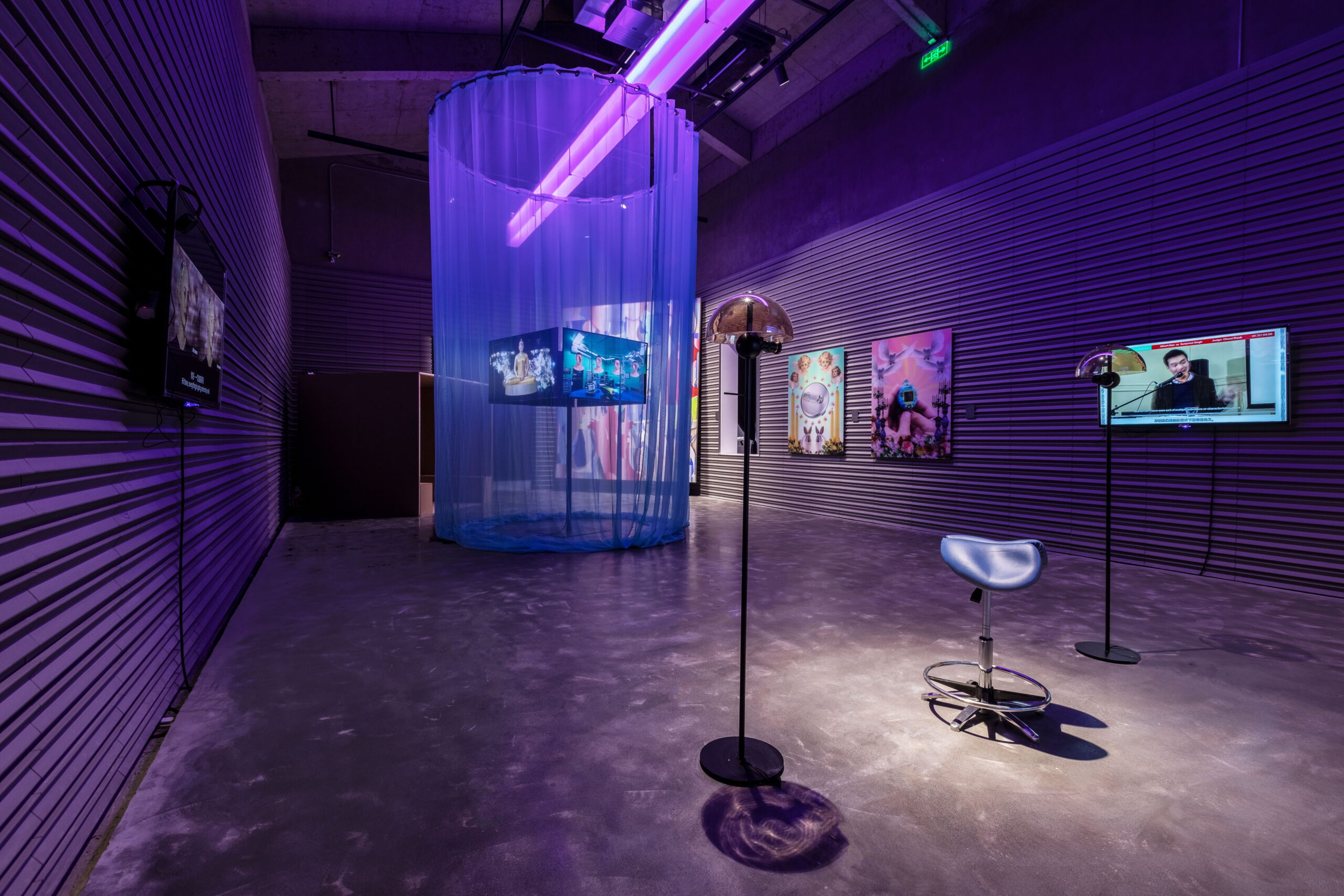
FOREWORD

X Museum Triennial is an ongoing investigation into the millennial zeitgeist through visual arts and many other disciplines that take part in sociocultural evolutions. It is a three-year rhythmic review of Chinese contemporary art and its development with a focus on emerging artists.
Precisely 100 years ago, the world’s first commercial radio station KDKA launched its inaugural broadcasting of the American presidential election in the early winter of 1920. The huge hit of live media combined with the political event marked the beginning of a new era of mass media.
Live media and live-ness have thereafter dramatically improved the efficiency of information sharing and further accelerated the process of globalization. Such qualities of live-ness echoed Aristotle’s elaboration on friendship and ‘consenting’ (synaisthanomenoi, sensing together), in which he said, ‘One must therefore also ‘con-sent’ that his friend exists, and this happens by living together and by sharing acts and thoughts in common (koinōnein)’. We might take Aristotle’s essence of sensing together into today’s spectrum of information sharing: unlike pre-digital age, current platforms of social media provide real-time communication and immersive experience for interactivity than merely producing content, our concurrent perceptions have therefore been increased than ever before. The expanded field that we inhabit, from XR (extended reality), AI (artificial intelligence) to recent implemented 5G data networks technology, consistently challenge the way we perceive things, sensing and living together.
The information age unfolds the world in front of us through screens and VR headset, audio-visual goes DRM-free, library is in the pocket, you can easily immerse yourself amongst master paintings and ancient artifacts through online exhibitions, gadgets as social enabler navigate us… Nevertheless, immaterial abundance and information excess, on the contrary, contributed to material insufficiency, it is rather a quest now for a perfect line to draw, and an ideal distance to create between ourselves and redundancy of information.
Contemporary art distance itself away from the confinements of time, genres, disciplinary boundaries, and representations; which is essentially an attempt to receive a precise reading of our time through this distance. Giorgio Agamben understands this distance as being able to perceive the ‘darkness’ and see its ‘obscurity’. The darkness, in neurophysiology, is a particular vision produced by the activation of ‘off-cells’ , therefore it is not emptiness or non-vision, but the vision that is caused by the activation of our own retinas. Contemporary artists are the ones who see and sense the world with one eye closed, perceive both the light and the darkness in a distance, as well as transferring knowledge and experience into material or intangible statements.
The millennial artists are surrounded by live media ever since they started to develop the curiosity of the world, witnessing the evolution of the internet. It is rather a second nature for them to work and examine through the lens of technology. Convergence in the modern age of humans and technology has created moments of amusement and convenience, along with fears and concerns at the same time. Artists place both outcomes on two poles of a scale; their works are reflections of the status of swinging left and right, without reaching a result.
ABOUT THE EXHIBITION
‘How Do We Begin?’ embraces the age that we inhabit, celebrates the accessibility of knowledge and information embodied by the digital age, experiences, and excitements brought by new media and edge-cutting technology. At the same time, it acknowledges the invasion of toxic information that shaping physical relationships and interrupting social structures. For individuals, the way we build connections with families, groups and ourselves have always been what Aristotle called ‘con-senting (synaisthanomenoi, sensing together)’. ‘Con-senting’ recognizes the significance of being in the same flux, construction of collective memories and divergent states of mind.
Characterised by sharing and mutuality, contemporary art went beyond the confinement of disciplinary boundaries and knowledge. ‘How Do We Begin?’ sees its exhibition spaces as sites of collaboration and production, is aiming to stimulate information and knowledge exchange between intellectual individuals.
Coincides with the century anniversary of the born of the first real-time mass media (KDKA), ‘How Do We Begin?’ invites contemporary artists as well as practitioners from other disciplines that take part in the progression of arts and humanity to reflect on the multifaceted phenomena of the Information Age, and imagines the significance by sensing, sharing and living together. Newest technologies and gadgets are extensions of human sensory organs, they enlarge our perceptions and emotions, at the same time synchronize us in the global world of immateriality, geographic boundaries are eliminated. Artists take phenomenological events from contemporary society as the starting point, to further contemplate now and speculate hereafter through multiple forms of visual arts and design.
Attempting to refine the evolving zeitgeist of the millennial, ‘How Do We Begin?’ actively invites and encourages audience and art practitioners to participate in and contribute to the discussion of millennial zeitgeist.
1. Media and Technology

2020 marks the beginning of ‘web 4.0’ in which intelligent virtual assistant will be implemented on every level of communication and interaction, and evolving through imitating human being; big data and personal information will become the bridge that links the virtual to the reality and blurs the boundaries between public and private.
Marshall McLuhan pointed out in 1964, still avant-garde: the courier, that is, media itself that carries the information change human perception of the world irrespective of the content, and media determine consciousness. Counterpoint made clear by Raymond Williams, who refuses McLuhan’s idea of the technology itself can determine human perception and social change, he sees social life and technology as inseparable things and thinks contents will be shaped by media forms.
Corresponsively, artists in this section approach the topic from two viewpoints: one focuses on the medium itself, interests in how, humans are building connections with technology and devices; the other stems from the content that new media produce, from the way social media disrupt real human interaction to the construction of self-censorship.
2. Social Reflector

Contemporary artists take references from popular images and objects to make critiques on the quotidian details that widely exist among people in the current social landscape. The world governed by digital circuit contributes to the production and dissemination of memes and Internet languages. To be internet-aware is probably the best way to reconcile with social network’s irruptive effects on aesthetics, culture, and society.
Optical fibre connects individuals, is both necessities and supplements of modern life. It is even difficult for us to imagine living in a world without the Internet, in a way, we cannot go back to pre-1970s. Internet proliferates the lost of shared objective standards for truth, DeepMind, and other technologies that contribute to circuitous slippage between facts and alt-facts in this post-truth era. For citizens of the modern metropolis, temporarily returning to a digital-free world has been advertised as meditations or even detox, what now, in any form, we can get rid of digital media prosthetics and reconnect with both spirituality of mind and physicality of body.
3. Artists and Architects as Narrator

History is never a singular narrative; cityscape, architectural vestiges, buildings, and its texture inform us the past and present of a place without bias or prejudice. The physical narrator architect, have long been deviated from the orbit of stacking living units, interested in how storytelling interweave with technological developments in contemporary cities, and how forms and physicality can resist, intervene, or co-exist with virtualized beings.
‘Customisation’ will no longer being used as a private, high-end marketing gimmick, algorithms and automation is replacing the old-fashioned architectural tailoring, where do architects find themselves in the world governed by algorithms and artificial intelligence? We might take inspiration from Le Corbusier’s 1923 ‘machines for living’, as something ‘dispositif (apparatus)’, that is, system of relations, mechanisms and knowledge structures that can be established within the social body. Artists and architects are producers of self-fulfilling dispositif (apparatus), they capture, orient, and intercept opinions, beliefs, and discourses of living beings. In this way, artists and architects provoke contemplation of the built environment around us without falling into the category of dystopia.
About The Artists
About The Curators




























